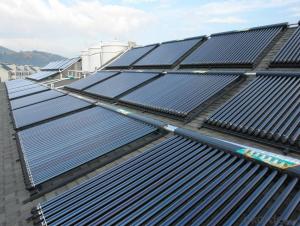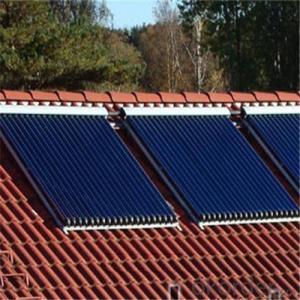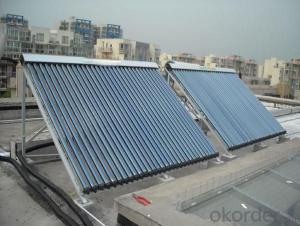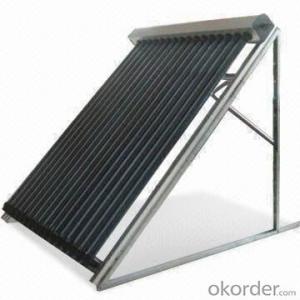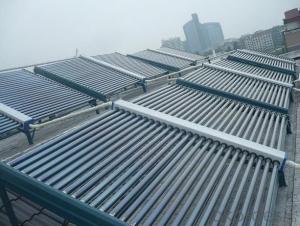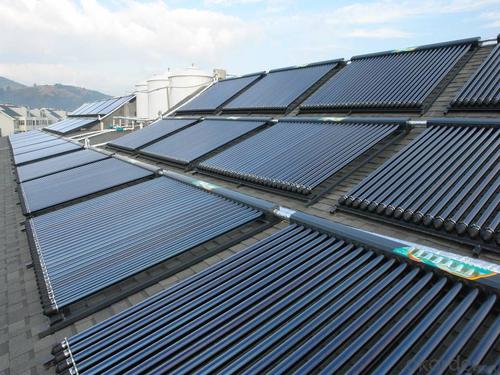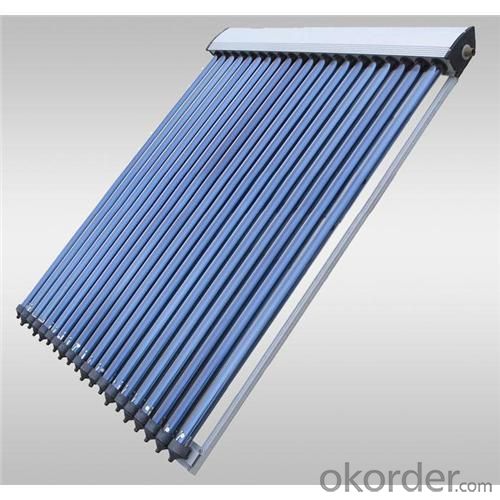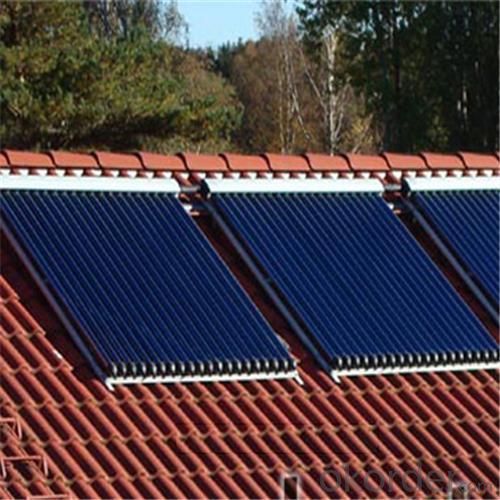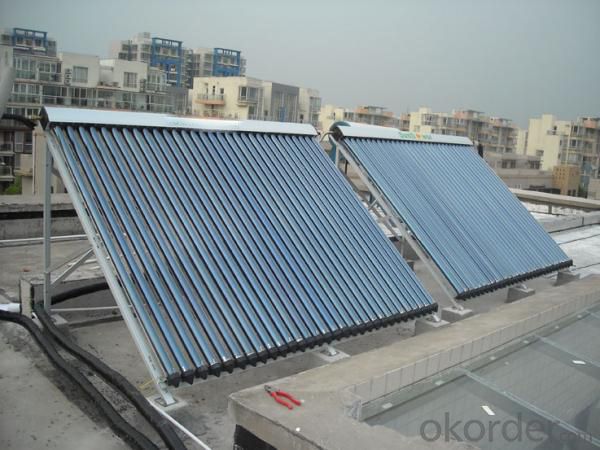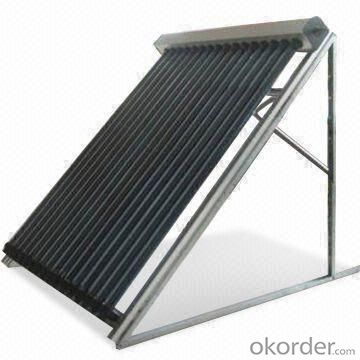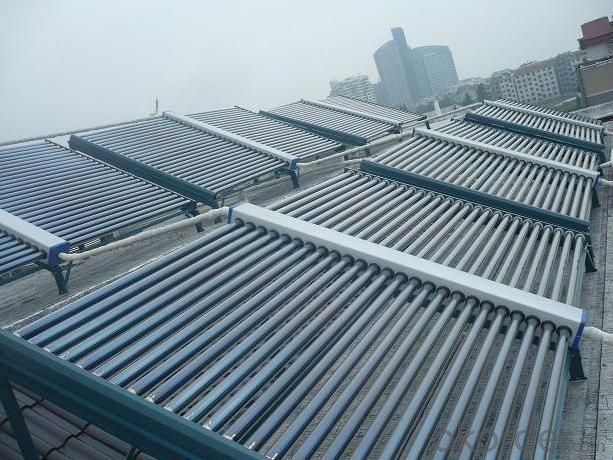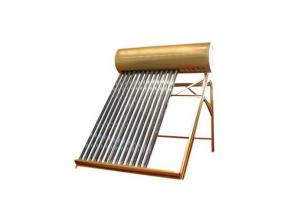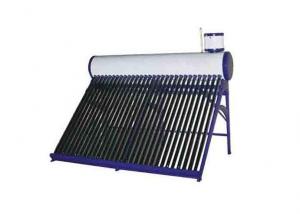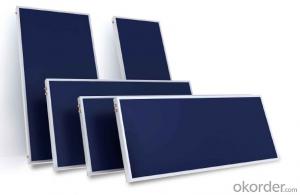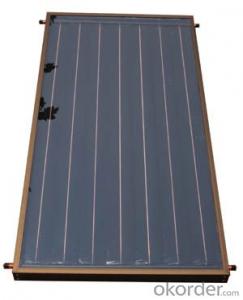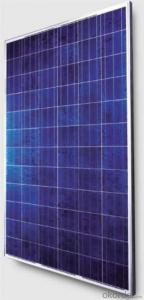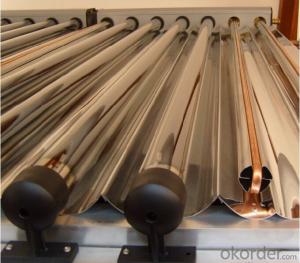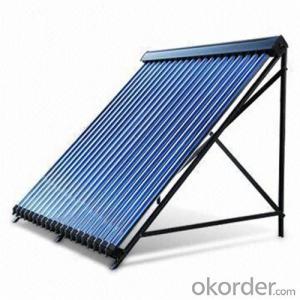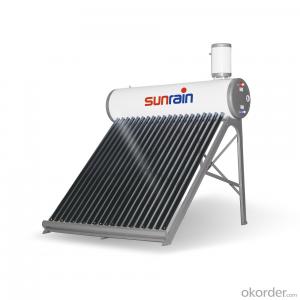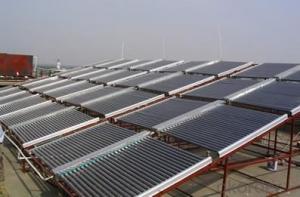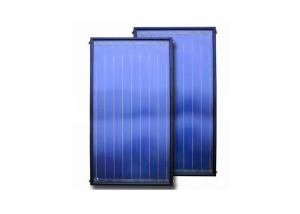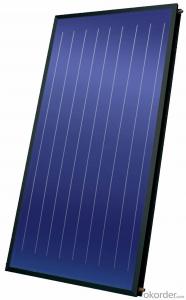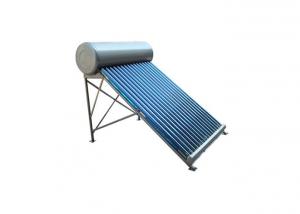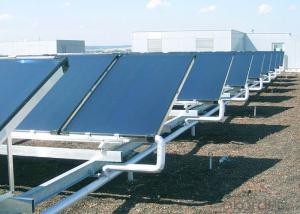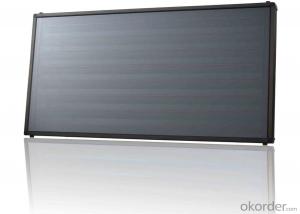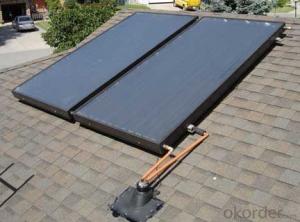Emissivity Solar Collectors for Water Heater, Pressurized Emissivity Solar Collectors
- Loading Port:
- China main port
- Payment Terms:
- TT OR LC
- Min Order Qty:
- 5 set
- Supply Capability:
- 10000 set/month
OKorder Service Pledge
OKorder Financial Service
You Might Also Like
Specification
manifold (inner) | red copper |
manifold (exterior) | aluminum alloy |
glass tube dimensions | 58mm * 1800mm |
daily efficiency | ≥55% |
heat preservation | 72 hours |
hail resistance | 25mm |
max pressure | 7 bar |
coating of vacuum tube | ALN/AIN-SS/CU |
heat pipe | anti-freezing > -35 degree |
certificate | Solar Keymark, EN12975,SRCC |
Serious Product
Models | L*W*H mm | Vacuum tube | Power output | Efficiency | Header mm | Frame | container loading 20FT/40HQ sets | Gross Weight kg |
SHC-8 | 1917*910*133 | 58*1800*8pcs | 939W | 0.668 | Φ35/1.0 | AL alloy | 185/445 | 27 |
SHC-10 | 1917*1130*133 | 58*1800*10pcs | 1189W | 159/385 | 33 | |||
SHC-12 | 1917*1350*133 | 58*1800*12pcs | 1440W | 149/358 | 40 | |||
SHC-15 | 1917*1680*133 | 58*1800*15pcs | 1815W | 120/290 | 49 | |||
SHC-18 | 1917*2010*133 | 58*1800*18pcs | 2191W | 100/242 | 59 | |||
SHC-20 | 1917*2230*133 | 58*1800*20pcs | 2442W | 87/210 | 66 | |||
SHC-22 | 1917*2450*133 | 58*1800*22pcs | 2692W | 83/202 | 72 | |||
SHC-24 | 1917*2670*133 | 58*1800*24pcs | 2943W | 77/188 | 79 |
Packaging & Delivery
Packaging Details: | Exporting Carton with big foaming protection |
Delivery Detail: | In 10-15 days |
Loading Quantity
Model | Tube | Tube Q.T.Y | Loading Q.T.Y/40HQ |
GSC15 | 58*1800mm | 15pcs | 315sets |
GSC18 | 58*1800mm | 18pcs | 265sets |
GSC20 | 58*1800mm | 20pcs | 248sets |
GSC22 | 58*1800mm | 22pcs | 225sets |
GSC25 | 58*1800mm | 25pcs | 200sets |
GSC30 | 58*1800mm | 30pcs | 168sets |
Details of solar collector:
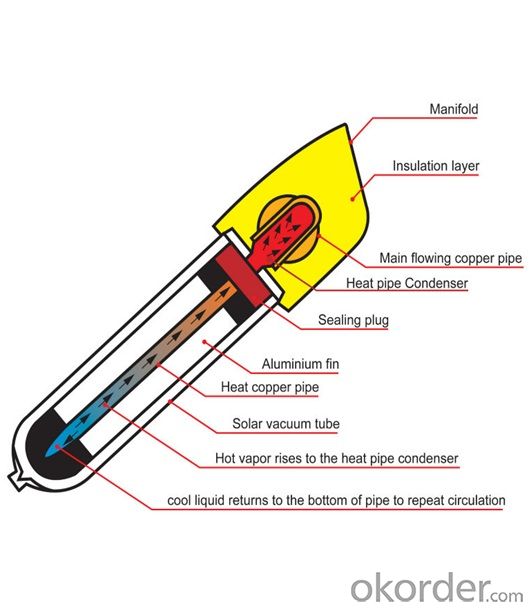
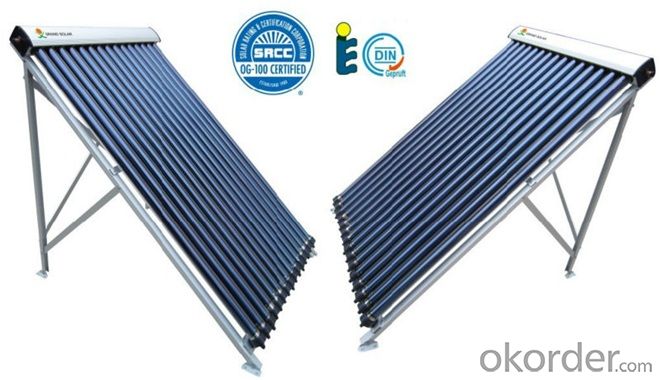

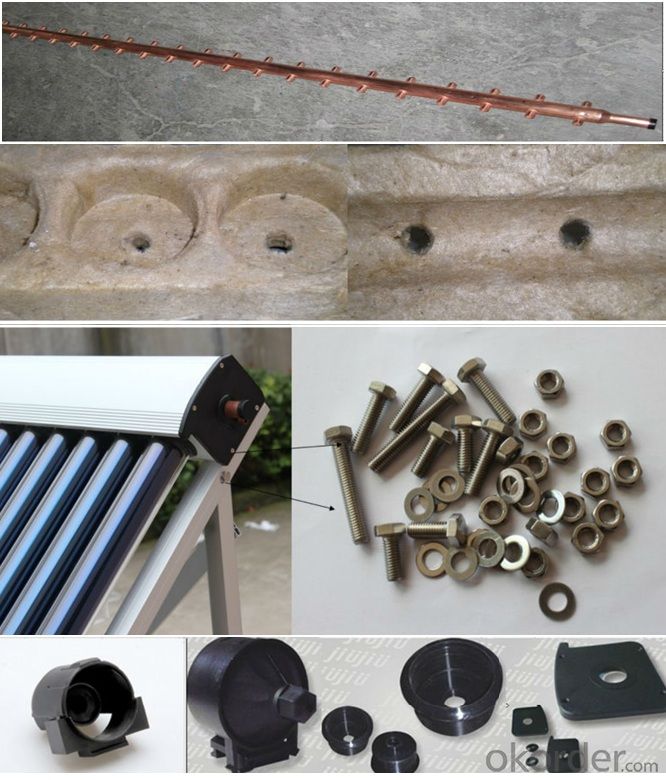
- Q: How do solar collectors compare to traditional heating methods?
- Solar collectors are a more sustainable and cost-effective alternative to traditional heating methods. They harness the energy from the sun to generate heat, reducing reliance on fossil fuels and lowering energy bills. While traditional heating methods rely on non-renewable resources and can be expensive, solar collectors offer a cleaner and more environmentally friendly solution.
- Q: Can solar collectors be used for heating poultry houses?
- Yes, solar collectors can be used for heating poultry houses. Solar thermal systems can be installed to capture solar energy and convert it into heat, which can then be used to warm the poultry houses. This renewable energy source can help reduce heating costs and environmental impact in poultry farming operations.
- Q: Can solar collectors be used for generating electricity on escalators?
- No, solar collectors cannot be used for generating electricity on escalators as they require a stationary surface to capture sunlight efficiently. Escalators are constantly in motion, making it impractical to install solar collectors on them.
- Q: Are there any safety concerns associated with solar collectors?
- Yes, there are a few safety concerns associated with solar collectors. One of the main concerns is the risk of fire. Due to the high temperatures and potential for overheating, proper installation and maintenance of solar collectors are necessary to prevent any fire hazards. Additionally, there is a risk of electrical shock during installation or maintenance if not done by trained professionals. Lastly, some solar collectors use potentially hazardous materials, such as lead or cadmium, which require proper handling and disposal to avoid environmental contamination. Overall, while solar collectors are generally safe, it is important to follow proper guidelines and precautions to mitigate any potential safety risks.
- Q: Can solar collectors be used in areas with high air pollution?
- Yes, solar collectors can still be used in areas with high air pollution. While air pollution can reduce the efficiency of solar collectors by blocking some sunlight, they can still generate electricity or heat. Regular maintenance and cleaning of the collectors may be required to remove any dust or pollutants that accumulate on the surface, ensuring optimal performance. Additionally, using advanced technologies and filters can help mitigate the impact of air pollution on solar collector efficiency in such areas.
- Q: Can solar collectors be used in biomass power plants?
- Solar collectors can indeed be employed in biomass power plants, which can ultimately improve the facility's efficiency and sustainability. By integrating solar collectors into biomass power plants, the overall effectiveness and environmental impact of the facility can be enhanced. Utilizing solar collectors enables the provision of supplementary heat to the biomass combustion process, thereby elevating energy output and decreasing dependence on fossil fuels. This integration allows for a consistent and dependable energy supply, as solar energy can be tapped into even during fluctuations in biomass fuel availability. Moreover, employing solar collectors in biomass power plants aids in reducing greenhouse gas emissions and mitigating the facility's environmental consequences. Ultimately, the combination of solar collectors and biomass power plants creates a more efficient and sustainable energy generation system.
- Q: How do solar collectors affect the insurance premiums of a property?
- Solar collectors can potentially affect insurance premiums of a property by increasing them due to the added value of the renewable energy system and its potential for damage or liability risks. However, some insurance providers also offer discounts or incentives for properties with solar collectors, as they can reduce the reliance on traditional energy sources and decrease the risk of certain types of damages. Ultimately, the impact on insurance premiums will depend on various factors, including the type and size of the solar installation, location, and the insurance company's policies.
- Q: How do solar collectors handle temperature fluctuations?
- Solar collectors are designed to handle temperature fluctuations by using materials and components that can withstand high temperatures. They are typically made with durable materials such as tempered glass or metal that can handle extreme heat without warping or breaking. Additionally, solar collectors often incorporate insulation to help minimize heat loss during colder temperatures. Overall, these design features enable solar collectors to effectively capture and convert sunlight into usable energy regardless of temperature fluctuations.
- Q: What is the optimal orientation for solar collectors?
- The optimal orientation for solar collectors depends on the geographic location and the specific goals of the solar energy system. In general, the ideal orientation for solar collectors is to face south in the northern hemisphere and north in the southern hemisphere. This allows the collectors to receive the maximum amount of sunlight throughout the day. By facing towards the equator, solar collectors can capture the most direct and intense sunlight, leading to higher energy production. This is especially important for solar thermal collectors that rely on direct sunlight to heat a fluid or generate steam. However, there are certain factors that may influence the optimal orientation. For instance, if the solar collectors are primarily used for electricity generation through photovoltaic (PV) panels, the orientation may be influenced by the peak electricity demand times. In this case, the collectors could be tilted towards the west to align with the late afternoon peak demand, maximizing the electricity output during that time. Additionally, the local climate and shading considerations should also be taken into account. Trees, buildings, or other obstructions can cast shadows on the solar collectors, reducing their efficiency. Evaluating the shading patterns throughout the day and year can help determine the optimal orientation and tilt angle to minimize shading. Furthermore, the angle of inclination or tilt can also impact the efficiency of solar collectors. The tilt angle is typically set to maximize the annual energy production by balancing the higher winter production with the lower summer production. The optimal tilt angle varies depending on the latitude of the location and the specific objectives of the solar energy system. In summary, the optimal orientation for solar collectors is typically south-facing in the northern hemisphere and north-facing in the southern hemisphere. However, other factors such as peak demand, shading, climate, and tilt angle should also be considered to maximize the energy production and efficiency of the solar energy system.
- Q: Can solar collectors be used for heating hospitals?
- Yes, solar collectors can be used for heating hospitals. Solar thermal systems can be installed to generate hot water or provide space heating in hospitals, reducing their reliance on traditional heating methods and lowering energy costs. Solar collectors capture sunlight and convert it into thermal energy, which can then be used for various heating purposes within the hospital.
Send your message to us
Emissivity Solar Collectors for Water Heater, Pressurized Emissivity Solar Collectors
- Loading Port:
- China main port
- Payment Terms:
- TT OR LC
- Min Order Qty:
- 5 set
- Supply Capability:
- 10000 set/month
OKorder Service Pledge
OKorder Financial Service
Similar products
Hot products
Hot Searches
Related keywords
